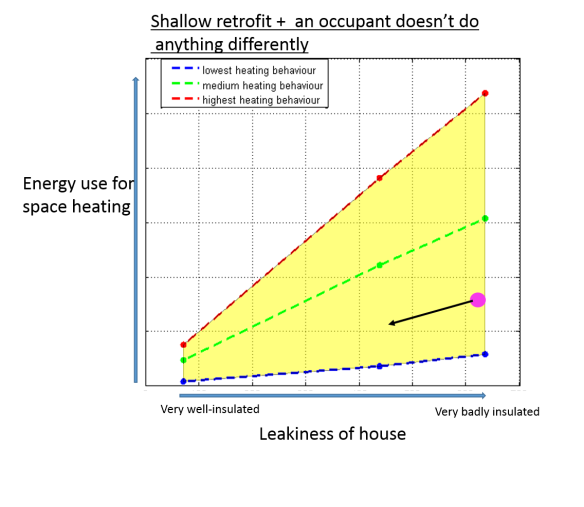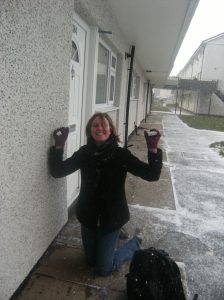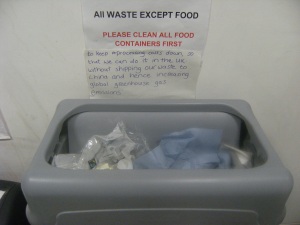Jenny Love, UCL Energy Institute
I’m going to be leaving academia in a couple of months. Aside from my colleagues being able to finally get some peace and quiet and not having their chocolate supplies taxed on regular occasions, there are some other benefits to this. One is that it has made me reflect on what I have learned whilst doing a PhD in energy and housing. Here are four reflections that you may find interesting.
1. We still don’t really understand a lot of factors behind energy use in buildings.
Much of the blame for this can be attributed to a poor evidence base for physical performance of houses. For example, not enough studies have measured energy use and linked it to real measurements of heat loss from the building. Researchers like Virginia Gori, Sofie Pelsmakers and Sam Stamp are working on these actual measurements.
If we don’t understand how energy is used in the first place, this makes knowing the effects of things like retrofit quite difficult to predict. Researchers like Ian Hamilton are using the best data we currently have to assess the effect of energy efficiency measures.
2. Social scientists and physicists/engineers must go further than just collaboration
We have an unfortunate tradition in our field of a lack of respect between physical scientists and social scientists. What I mean by saying we must go further than collaboration is not just working together and bearing with each other – but setting an example of genuine appreciation of the other’s discipline – including stopping dissing each other’s disciplines behind our mutual backs. When I started my PhD I didn’t know much about social science, and therefore used to be quite rude about it. Now I have come to see that it’s the people who bring about the physics in buildings that I like to study. For example, I described here how when houses are retrofitted, the outcome is determined by the amount by which the occupants adjust the heating. Researchers have to understand what made the occupants adjust the heating, and then the effect that this has on energy use.
The best combination of social science and physics in one project I’ve seen is the work Lai Fong Chiu and Bob Lowe‘s Retrofit Insights team are doing, here. As it happens, the two lead authors of this study are married. Now, although this happened before they wrote the study, there’s nothing to say it couldn’t happen the other way round – you never know, multidisciplinary collaboration could lead to love. In my role as Dr. Love I’m happy to point you towards eligible physical or social scientists with whom you could start a multidisciplinary collaboration.
Another person to keep your eye on is Adam Cooper of UCL STEaPP, who is doing great work in starting to develop the theoretical framework within which social science and physics can fit together in order to study energy use.
3. ‘Behaviour Change’, like religion, is (mis)used as an excuse for all kinds of wrongs
What I mean by ‘Behaviour Change’ is trying to get occupants to reduce their energy use by changing their home heating behaviour. This is only beneficial if there is actual evidence that occupants are exhibiting wasteful behaviours in the first place. In my case study sample in social housing, many of them were heating far less than average and trying to get them to turn the heating down would not only be morally wrong but also bad for the house (leading to more mould, etc).
The second problem I have with ‘Behaviour Change’ is that it is sometimes used as a pretend solution in order to avoid the real issue – the fact that our housing stock is among the least thermally efficient in Europe. We need to get on with insulating it, instead of trying to make people colder by using less heating.
I’m certainly not against occupant engagement. Quite the opposite. What I would recommend it looks like is firstly listening to the occupants about how they do use the heating, and then, only if they are up for it, deliver tailored advice which will help them meet their heating needs using less energy. Also. we should be giving advice on wider aspects of maintaining a healthy home, like how to ventilate adequately.
4. Separate energy/climate change policy from warmth policy.
A crude description of the way retrofit policies worked during the time of my PhD is that energy companies ‘offset’ their CO2 emissions by funding retrofit of social housing. There is very little measurement of whether energy or CO2 has actually been saved, but if there were, it would be seen that some occupants do not save energy but have a warmer home instead – in fact, this is what the occupants need. However, this would be counted as essentially a failed policy, even though the occupants now have a better quality of life. Maybe that’s why no one measures the actual savings.
There are two agendas going on here – allowing people to be warm in their homes, which is very important, and mitigating climate change by reducing energy use, which is also very important but is the opposite to making people warmer. The more you do of one, the less you do of the other: in my mind, the trade-off is like this:
I think our climate change and energy demand reduction policies should not target
social housing – there are plenty of other places to focus energy demand at. This sector
needs policies measured in terms how much more comfortable the previously-cold
occupants become.
Conclusion
So, there are some thoughts. I invite you to challenge or add to any of them in the
comment section below. As always, feel free to contact me on Jennifer.love.09@ucl.ac.uk if you would like to have a more detailed discussion on anything raised above or have any questions about energy and climate change in general.























